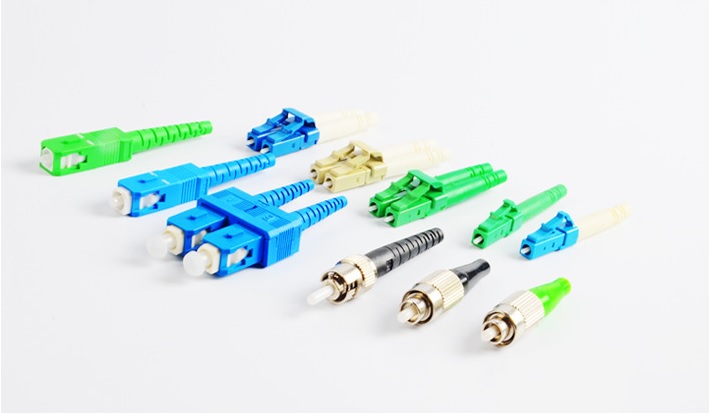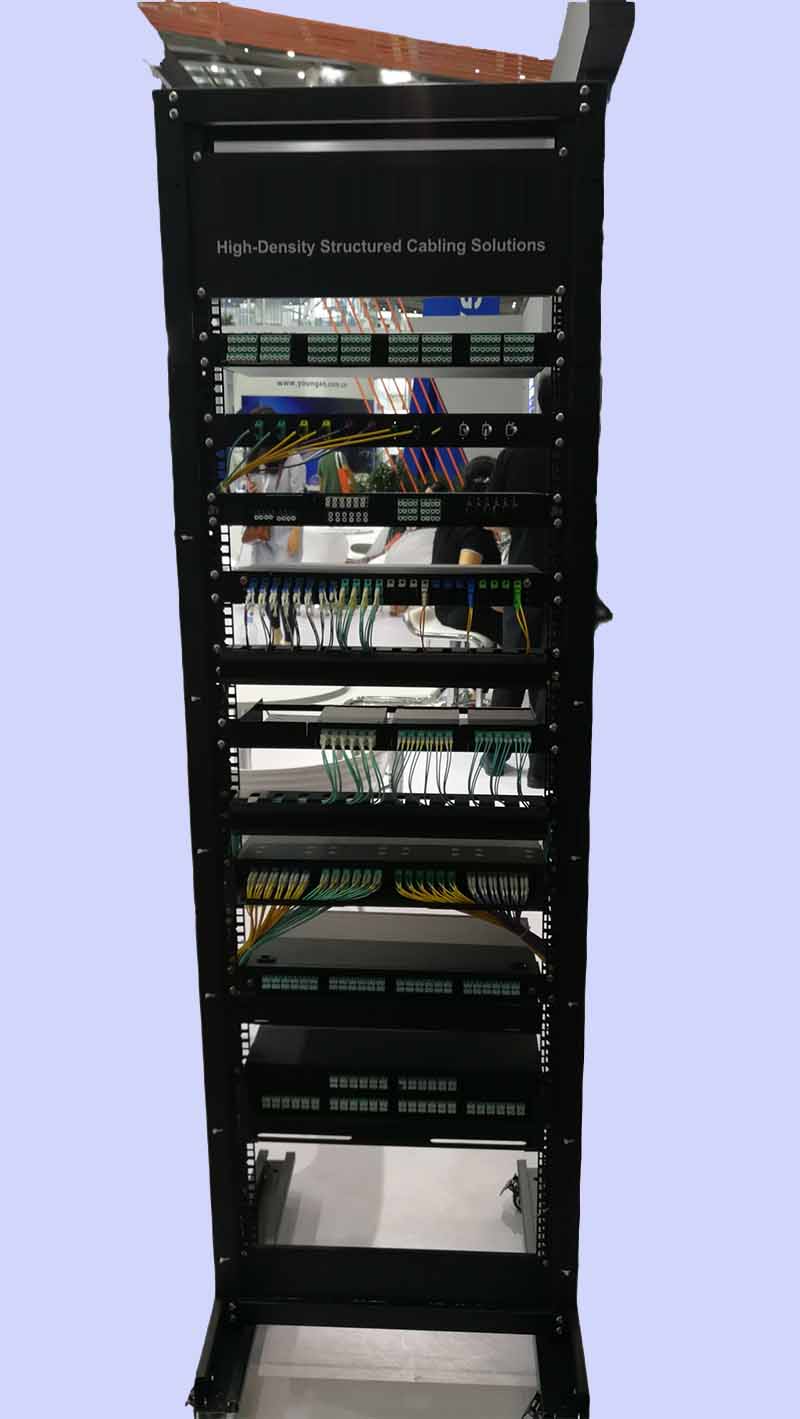How to Manage Fiber Patch Cords for Integrated Cabling Systems
2020/5/1 9:08:43
Overview.
For integrated cabling, the importance of telecommunication and equipment is self-evident as the meeting place for data, voice and image services. However, they have gone to great lengths in terms of overall design, equipment shaping, hardware configuration, construction and maintenance. However, the construction party often neglects the telecom and equipment room inside the largest number of equipment maintenance and installation protection - cable, fiber optic jumper, and ignore this problem, will bring a lot of trouble to our computer room management. So, how can integrated cabling systems fiber optic patch cords be managed well?

I. What are the types of fiber optic jumpers/patch cords?
(i) Classification by type of fibre
1. Single-mode fiber-optic patch cords: generally yellow, blue connectors and protective sleeves, long transmission distance.
2. Multimode fiber optic patch cords: generally orange or aqua blue, beige or black for connectors and protective covers, short transmission distance.
(b) Classification by connector type
Fiber-optic patch cords according to the connector classification can be divided into FC, ST, SC, LC, MU, E2000, MTRJ, SMA, etc., the following is a detailed description of the common fiber-optic patch cords.
1. FC fibre-optic jumpers
FC (Ferrule Connector) fiber jumpers are among the most common connection devices in single-mode networks. It is externally reinforced with a metal sleeve and fastened with a screw fastener. Commonly found on the ODF side (most often seen on the distribution rack), FC connectors are generally used more often in telecom networks, the advantage is that they are reliable and dustproof, the disadvantage is that they take a little longer to install.
2. ST fibre-optic jumpers
ST (Stab & Twist) fiber jumpers are the most common connection device in multimode networks and are the more common type of connector in Base10 fiber connections. Often used on fiber optic distribution racks. The shell is round, the fastening method is screwed, the core is exposed, need to be inserted first, then rotate half a week to fix the bayonet.
3. SC fibre-optic jumpers
SC (Square Connector) fiber-optic patch cable is a standardized connector of TIA-568-A. It was not widely used at the beginning due to its high price, but later it was used to connect with GBIC optical modules due to its excellent performance. Commonly used in router switches, the housing is rectangular and the fastening method is plug-and-latch, unlike ST/FC, does not require rotation.
4. LC fibre-optic jumpers
LC (Lucent connector) fiber optic jumpers are usually connected to SFP optical modules. The connector is similar to, but smaller than, the SC connector, with a pin and sleeve size of 1.25mm, half the size of regular SC and FC, and fastened by a jack latch. Its advantages are good performance, to some extent can improve the density of fiber optic connectors in the fiber distribution frame, is a good single-mode fiber patch cord.

(iii) Classification by application of jumpers
Fiber-optic jumpers according to the application of jumpers are generally divided into MTP/MPO fiber-optic jumpers, conventional fiber-optic jumpers, armored fiber-optic jumpers, etc.
1. MTP/MPO fiber optic jumper: common in the cabling process requires high-density integrated fiber optic line environment, its advantages: the use of simple push-pull locking structure, easy installation and removal, saving time and cost, can maximize the service life.
2. Armored fiber-optic patch cords: common in machine rooms, suitable for harsh environment. Its advantages: no need to use protective casing, moisture and fire resistance, anti-static and acid and alkali resistance, can save space and reduce construction costs.
3. Conventional optical fiber jumper: conventional optical fiber jumper OS2 9/125 single-mode single, OM4 40/100Gb 50/125 multi-mode, OM3 10Gb 50/125 multi-mode, OM2 50/125 multi-mode, OM1 62.5/125 multi-mode, OS2 9/125 single-mode single, OM5 50/125 multi-mode types.
The OM5 fiber optic jumper is a popular product nowadays, often used for higher broadband applications, the outer sheath is aqua green, with strong scalability, compatibility and interoperability, can effectively reduce costs.
Second, how to manage the integrated cabling system fiber optic patch cords
In general, reasonable jumper management can be divided into 5 stages: planning, preparation, wiring, testing, validation.
1 Jumper Code of Practice
1.1 Plan
To do anything in advance requires thorough planning. For jumper management, planning for present and future needs should be done.
(1.1.1) Change requests. All administrative activities, moves, additions or changes (MACs) start with a change request. The change request must contain all information necessary to initiate the planning process.
(1.1.2) Search records. Upon receipt of the request form, the records should be searched to determine the circuit path used.
(1.1.3) Proper routing. Before determining the correct jumper length, first find the best route between the ports to be connected. Usually the shortest cause for passing horizontal and vertical cable conduits and must not obstruct or interfere with other jumper wires or connectors in the distribution frame. Select the jumper, avoid excessive slack and ensure a neat appearance. Too tight a jumper will increase the tension on the connector, and too slack will bring trouble to the jumper management, increasing the difficulty of managing the wiring rack.
1.2 Preparation
After doing a good plan for jumper management, then you should follow the plan well in advance, and then you should do a good job of preparing for jumper management. Do as much preparation as possible to study management records before implementing management operations. Determine the location of the ports to be connected and reconnected and the label information for the associated ports.
(1.2.1) Check first the type of jumper needed and then the quality of that jumper. In order to ensure that the quality of the jumper is correct, it is necessary to check whether the jumper is damaged, in order to check whether it is damaged, of course, the jumper can first be viewed from the appearance of the jumper, if necessary, can be checked with a professional instrument.
(1.2.2) Next, check the condition of the required connection site to avoid physical damage to the connection site.
(1.2.3) Finally, the jumper joints and connection parts need to be cleaned.
There are two methods of cleaning fibre optic connectors, contact and non-contact.
Contact cleaning methods.
(1) Wiping paper and anhydrous alcohol, using virgin wood pulp with special processing technology, ultra-low dust, pure texture, highly efficient water absorption, delicate paper, will not scratch the surface of the inserts, with low dust wiping paper with anhydrous alcohol to wipe the optical fiber connector.
(2) non-woven fabric, does not produce fiber scraps, strong, does not have any chemical impurities, silky soft, does not cause allergic reactions, and not easy to lint and lint, is as fiber optic connectors or pins production or testing wipes ideal for cleaning, in the process of use with anhydrous alcohol to wipe the fiber optic connectors.
(3) Cleaning swabs, specifically designed for internal cleaning of ceramic sleeves, or for cleaning hard-to-reach cartridge ends in flanges (or adapters).
(4) Professional cleaner, the fiber optic connector special cleaner uses a special rolled wiping tape in a rollable housing, no alcohol, each cleaning is very effective and produces a new surface, convenient and practical.
Non-contact methods.
(1) The ultrasonic cleaning method, which converts the cleaning fluid into an ultrasonic "column" to the connector face, where the waste fluid is recovered and sucked clean in the same small space.
(2) High-pressure blowing method, its principle is to apply cleaning fluid to the connector end surface, and then blow with high-pressure air against the connector end surface.
(1.2.4) Check fibre optic connector cleanliness
After cleaning the fiber optic connector, the end joint must be inspected. It is common practice to use a 100, 200 or 400x magnifying glass for inspection, and the diagram below shows the fiber optic end joints in a clean state and after they have been contaminated.
Jumper management, regardless of the method, for some seriously contaminated connectors or difficult to clean, with the use of cotton swabs and alcohol and other cleaning solutions need to be treated.
After this series of preparations, it means that the wiring for jumper management can begin.
1.3 Wiring
The installation of the distribution frame shall be carried out in accordance with the operating procedures. Knots, burrs, hoop shrinkage and poor contact during jumper construction can significantly reduce jumper performance. If such problems are to be avoided, the following factors should be given priority.
(1) Bending radius
The minimum allowable bend radius of the jumper is subject to the jumper manufacturer's specifications.
The standard states that the minimum bending radius of unshielded twisted pair (UTP) should be four times the cable diameter, while shielded twisted pair is eight times the cable diameter.The minimum bending radius of 2 or 4 core horizontal cable is greater than 25mm, if the bending radius is less than this standard, it may result in a change in the relative position of the wire, resulting in reduced transmission performance.
(2) Jumper tensile and stress
Do not overexert yourself during wiring, as this may increase the stress on the jumper and connector, resulting in reduced performance.
(3) Bundling
Jumper wire does not necessarily need to be tied, if the tying needs to comply with the manufacturer's tying principles, do not tie too tightly, or it will cause deformation of the strand. Do not over-tighten the clamps, and make sure that each jumper is free to turn. Please use specialized products and consider choosing products that can be used repeatedly without tools, such as Velcro straps.
1.4 Testing
(1) Although the jumper wiring has been completed, it may not be considered that the fiber optic link or copper link is in full compliance with the code of practice or comprehensive wiring international and national standards, then the fiber optic link or copper cable test should be carried out, only after meeting the test standard can be concluded whether the test standard.
1.5 Validation
(1) It's worth taking the time to do a final visual check of the connection. Make sure jumper slack is not knotted and not caught in the cabinet door.
(2) The last step is to update the record according to the current configuration and close the work order related to the change request that has been executed.
Patch cords are now an important part of an integrated cabling system, and this is especially true for the well-managed operation of patch cords in data center projects. It is believed that as long as the construction management personnel correctly and reasonably jumper management operation, it will make the whole integrated wiring become a truly advanced, scientific, practical and reliable system.

With a large number of data center applications of 10G/40G/100G networks, the installation and management of field patch cords has become more and more important, good patch cords management sometimes affects the overall channel attenuation, good management to ensure that the Fibre Channel data transmission is in the best state, process operations such as planning, preparation, wiring, testing, verification of these steps of operation and management will be important to ensure system quality.




